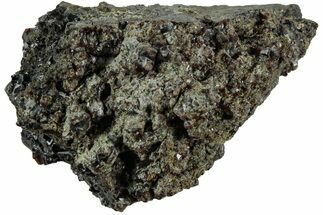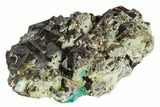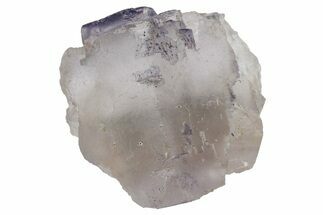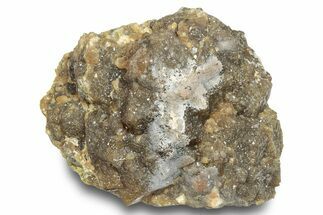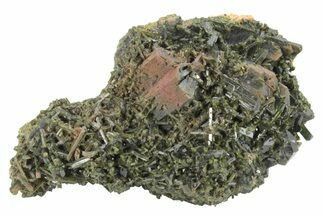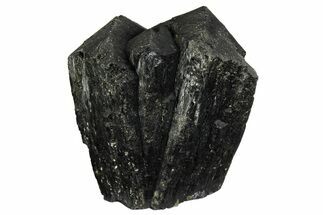This Specimen has been sold.
2.5" Garnet Cluster with Mica, Feldspar and Epidote- Pakistan
This garnet centered specimen comes from a location in Pakistan, where associations of deep orange/brown garnets, feldspar, golden mica and green epidote. The garnets from this location display a unique pattern, which can be seen along the faces of the crystals when rotated under light.
Small light and dark green epidote crystals can be found stemming from the superior portion of this mineral specimen. Microscopic translucent epidote crystals give some portions of this garnet cluster specimen a druzy appearance. On the inferior side of the garnet cluster is a bed of feldspar matrix, as well as small golden flakes of mica.
There is a strange vibrant blue mineralization on what could be considered the underside of this specimen, however it remains unidentified.
Small light and dark green epidote crystals can be found stemming from the superior portion of this mineral specimen. Microscopic translucent epidote crystals give some portions of this garnet cluster specimen a druzy appearance. On the inferior side of the garnet cluster is a bed of feldspar matrix, as well as small golden flakes of mica.
There is a strange vibrant blue mineralization on what could be considered the underside of this specimen, however it remains unidentified.
About Epidote
Epidote is a striking and often green mineral known for its complex crystal structure and vitreous luster. It is a calcium aluminum iron silicate that commonly forms in metamorphic rocks, particularly in regions that have undergone low to medium-grade metamorphism. The color of epidote typically ranges from pistachio green to dark green, although it can occasionally appear yellowish-green or even brown due to varying iron content.
Epidote crystals can appear in prismatic, slender forms or as aggregates, and they often exhibit striations along their length. The mineral’s translucent to transparent appearance and high refractive index give it an attractive, glassy shine.
It is commonly associated with minerals such as quartz, feldspar, and garnet, often forming in metamorphic rocks like schist and gneiss. It can also be found in skarn deposits alongside minerals like calcite, diopside, and amphiboles. These associations can provide insights into the geologic history and metamorphic conditions of the region. Epidote is found in locations worldwide, with notable sources including Austria, Norway, Pakistan, and parts of the United States. Collectors prize epidote for its unique green hues and well-formed crystal clusters.
Epidote is a striking and often green mineral known for its complex crystal structure and vitreous luster. It is a calcium aluminum iron silicate that commonly forms in metamorphic rocks, particularly in regions that have undergone low to medium-grade metamorphism. The color of epidote typically ranges from pistachio green to dark green, although it can occasionally appear yellowish-green or even brown due to varying iron content.
Epidote crystals can appear in prismatic, slender forms or as aggregates, and they often exhibit striations along their length. The mineral’s translucent to transparent appearance and high refractive index give it an attractive, glassy shine.
It is commonly associated with minerals such as quartz, feldspar, and garnet, often forming in metamorphic rocks like schist and gneiss. It can also be found in skarn deposits alongside minerals like calcite, diopside, and amphiboles. These associations can provide insights into the geologic history and metamorphic conditions of the region. Epidote is found in locations worldwide, with notable sources including Austria, Norway, Pakistan, and parts of the United States. Collectors prize epidote for its unique green hues and well-formed crystal clusters.
Feldspars are a group of rock-forming tectosilicate minerals. They are the most common minerals on Earth, making up nearly 60% of the crust.
Garnets are nesosilicates with the general formula X3Y2(SiO4)3. Garnets come in many species, including pyrope, almandine (the most common species), spessartine, uvarovite, andradite and grossular, varieties of which are hessonite, cinnamon-stone, and tsavorite. Garnets are found in a wide variety of colors including red, orange, yellow, green, purple, brown, blue, black, pink, and colorless, though reddish shades are the most common.
SPECIES
Garnet, Epidote, Mica & Feldspar
LOCATION
Raskoh, Kharan, Balochistan, Pakistan
SIZE
2.5 x 1.7"
CATEGORY
SUB CATEGORY
ITEM
#100402
 Reviews
Reviews

